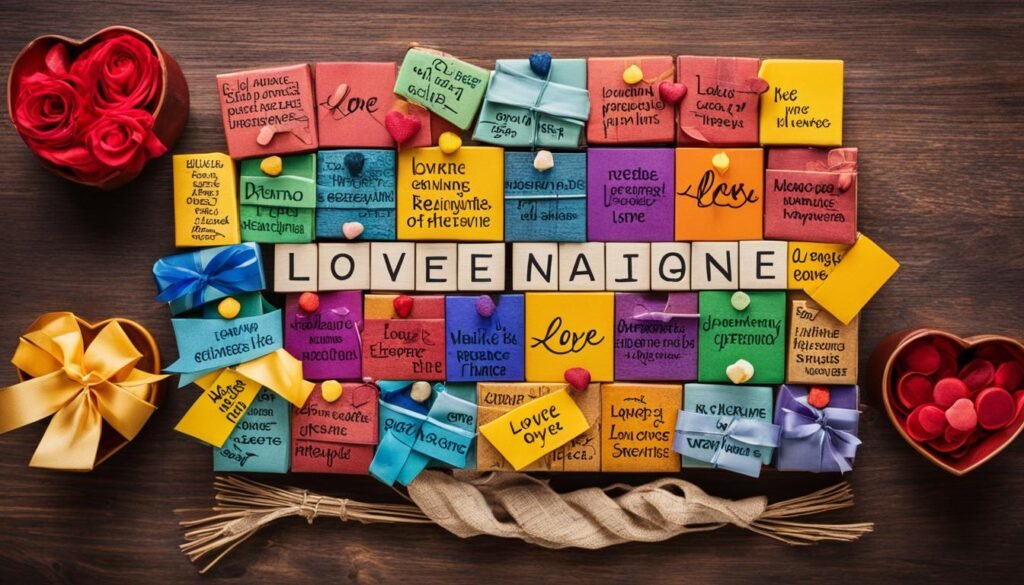Love is a powerful emotion that binds two people in a unique and intimate relationship. But have you ever felt like you and your partner are on different wavelengths when it comes to expressing love? This is where love languages come into play, a concept that has gained popularity in recent years. But are love languages real, or just a gimmick?
In this section, we will explore the validity of love languages as a concept and its importance in forming deeper emotional connections and bonds with our partners.
Key Takeaways
- The concept of love languages has gained popularity in recent years as a means of enhancing emotional connections in relationships.
- Understanding your partner’s love language can greatly enhance communication and emotional intimacy.
- There is scientific evidence supporting the validity of love languages in relationships.
- Discovering your partner’s love language can be done through various love languages tests and quizzes available online.
- Embracing and prioritizing love languages can be a powerful tool in building stronger and more fulfilling relationships.
Exploring Love Languages and Their Types
Love languages are the different ways individuals express and receive love in relationships. Understanding your partner’s love language and communicating with them effectively can help foster deeper connections and emotional intimacy. Dr. Gary Chapman, a renowned marriage counselor and author, proposed five love languages that individuals commonly use to express love:
| Love Language | Definition |
|---|---|
| Words of Affirmation | Expressing love through words of encouragement, praise, and appreciation. |
| Acts of Service | Showcasing love by doing helpful and kind gestures for your partner. |
| Receiving Gifts | Feeling loved by receiving thoughtful gifts and gestures. |
| Quality Time | Showing love by spending quality, undivided attention with your partner. |
| Physical Touch | Expressing love through physical gestures such as holding hands or hugging. |
Regardless of your love language, it’s important to recognize and appreciate your partner’s love language too. By understanding and adapting to different love languages, couples can build stronger and more fulfilling relationships.
“Your love language and that of your spouse may be as different as Chinese is from English. No matter how hard you try to express love in English, if your spouse understands only Chinese, you will never understand how to love each other. Very often couples begin to argue because he or she is not meeting the emotional needs of the spouse. In my experience, only one person is emotionally explosive and that is not the husband or wife who feels loved” – Dr. Gary Chapman, The Five Love Languages: How to Express Heartfelt Commitment to Your Mate.

The Science Behind Love Languages and Emotional Expression
Love languages are not just a mere concept, but they have scientific evidence supporting their validity. According to a study published in the journal Psychological Science, emotional expressions activate specific areas of the brain related to the expressed emotion.
In a relationship, understanding your partner’s love language can enhance emotional intimacy, as it helps you tailor your expressions to their specific needs. For example, if your partner’s love language is physical touch, holding hands or cuddling can improve their emotional well-being and satisfaction in the relationship.
On the other hand, neglecting your partner’s love language can lead to frustration and misunderstandings. Without clear communication and understanding of each other’s love languages, it can be difficult to form deeper emotional connections in a relationship.
The Impact of Love Languages on Emotional Well-Being
Studies have shown that incorporating love languages in relationships can have a positive impact on emotional well-being. A research article published in the Journal of Happiness Studies found that individuals who received love consistent with their preferred love language experienced higher levels of satisfaction, contentment, and overall happiness in their relationships.
Furthermore, understanding your own love language and communicating it to your partner can help you receive the emotional support you need, leading to better mental health and emotional well-being.
The Importance of Understanding Love Languages in Relationships
One of the main benefits of understanding love languages is that it can help individuals approach their relationships with empathy and compassion. By acknowledging and respecting our partner’s emotional needs, we can create a more supportive and fulfilling relationship.
In conclusion, understanding love languages is essential in forming deeper emotional connections and enhancing our relationships. By incorporating love languages into our communication and expressions, we can lead to better emotional well-being and satisfaction in our relationships. Consider taking a love languages test or quiz with your partner to gain more insight and help develop a stronger emotional bond.

Conclusion
In conclusion, understanding and communicating in accordance with your partner’s love language is crucial to forming deeper emotional connections and bonds. Throughout this article, we have explored various love languages and their types. We have shed light on the scientific evidence supporting their validity and the impact they can have on emotional well-being and satisfaction in relationships.
There are several love languages tests and quizzes available, including the official Love Languages quiz, which can help individuals discover their own and their partner’s love languages. It’s important to note that discovering your love language is just the first step. Embracing and prioritizing it in your relationship is what truly matters.
Dr. Gary Chapman’s book, “The 5 Love Languages: The Secret to Love That Lasts” is a great resource for individuals looking to dive deeper into their love languages.
By embracing and prioritizing love languages, you can enhance your relationship and foster emotional intimacy. Remember, the importance of love languages cannot be overstated. It’s up to you to take the first step and discover your own and your partner’s love language. Your relationship will thank you.
FAQ
Are love languages real?
Yes, love languages are real. They are a concept proposed by Dr. Gary Chapman, a renowned relationship counselor and author. Love languages refer to the ways in which individuals express and receive love. Understanding and communicating in accordance with each other’s love language can significantly enhance a relationship.
What are the different types of love languages?
Dr. Gary Chapman identified five love languages: words of affirmation, acts of service, receiving gifts, quality time, and physical touch. Words of affirmation involve verbal compliments and kind words, acts of service refer to doing helpful things for your partner, receiving gifts are tangible symbols of love, quality time means spending undivided attention with your partner, and physical touch involves physical affection and closeness.
How can understanding love languages benefit relationships?
Understanding love languages can benefit relationships by improving communication, strengthening emotional connection, and fostering greater intimacy. When you understand your partner’s love language and prioritize it, they feel valued and loved in their preferred way, leading to a deeper bond and mutual satisfaction.
Is there scientific evidence supporting love languages?
While the concept of love languages may not have extensive scientific research, there is evidence that love and emotional expressions affect our brain’s reward centers and emotional well-being. Understanding love languages can help individuals meet each other’s emotional needs, leading to greater relationship satisfaction.
How can I discover my own and my partner’s love language?
There are various love languages tests and quizzes available online. These tools can help you identify your own love language as well as that of your partner. Additionally, Dr. Gary Chapman has authored several books on love languages that provide in-depth insights and guidance on discovering and communicating in love languages.
What is the importance of love languages in relationships?
Love languages play a crucial role in relationships as they enable individuals to connect with their partners on a deeper emotional level. By understanding and speaking each other’s love language, couples can better express their love and meet each other’s emotional needs, leading to a more fulfilling and harmonious relationship.

